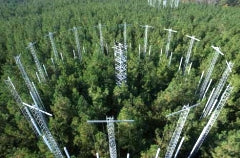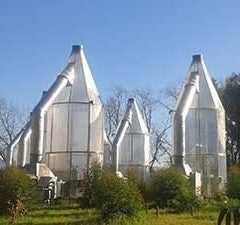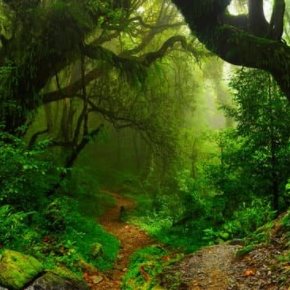News
Sidebar
Categories
Senseair CO2 Sensor Pressure Dependence
All infrared (NDIR) CO2 sensors have a dependence on pressure. This is because of the physics principle used to measure CO2 concentration.
The NDIR type of sensor measures the IR radiation absorbed by CO2 molecules, which corresponds to the mole concentration. When pressure increases, the number of molecules in a given volume also increases linearly. Conversely, when pressure decreases (higher altitudes, for example) the number of molecules decrease.
This app note includes both general information about Senseair sensors and pressure, as well as the equation for computing true CO2 level readings at various pressures useful for any NDIR CO2 sensor.
Click here to read or download the app note (pdf).
Note that like CO2 sensors, oxygen sensors are also pressure and altitude dependent. We had a client in Bangalore, India purchase a CM-0505 O2 Data Logger. He reported that it was reading 18.3% instead of the expected 20.9% when exposed to outdoor ambient air.
I looked up the Bangalore, India Airport information and found that the altitude was 2,890 feet above sea level. Using this chart we found online, we were able to confirm for the client that in fact, his meter was performing within the expected tolerances.
Methane Sensor Used in Science Fair Project
Middle school science experiment discovers natural way of producing methane, generating enough energy to power household appliances for days.
Can CO2 influence plant transpiration and biodiversity?
Guest post by Michael Forster, Edaphic Scientific Pty Ltd
Everyone knows that plants need carbon dioxide to grow. But fewer people know that carbon dioxide can also effect plant transpiration and even the water balance of entire ecosystems and catchments. Even fewer people know that carbon dioxide can affect biodiversity and which plant species are more common than other species.
Let’s just leave aside all of the topics on how increasing carbon dioxide is leading to global warming and how this, in turn, is impacting on plant species. Let’s just focus purely on how increasing atmospheric carbon dioxide changes the fundamental physiology of plants and how this, in turn, can lead to changes in transpiration and which species are more common in a forest.
Firstly, how do we know all of this? Scientists have been conducting experiments for years now where they have artificially increased atmospheric carbon dioxide around plants and forests.

They do this via experiments called FACE – or Free Air Carbon Enrichment – where massive towers gorge out copious amounts of CO2. Image: FACE experiment at Duke University, North Carolina, USA (source: https://www.czen.org/content/duke-forest-face-experiment)

What these experiments have generally shown is that plants actually like it when there is more carbon dioxide in the atmosphere. Plants generally grow larger and faster with more CO2. The process is similar to when you add fertilizer to the soil to assist the plant’s growth. Instead, we are adding fertilizer to the atmosphere in the form of more carbon dioxide. As there is more carbon dioxide in the atmosphere, it is generally easier for plants to perform photosynthesis and accumulate biomass.
In terms of transpiration, or plant water use, an increase in atmospheric CO2 means that stomata, or the pores on leaves that exchange gases between the leaf and the atmosphere, do not need to open as much. This means that, at the scale of a leaf, less water is lost and there is lower transpiration. With increased photosynthesis and lower water loss, then the water efficiency of plants is increased.
So it seems that more carbon dioxide in the atmosphere is a good thing for plants – they grow faster and use less water. However, nothing in biology is so simple. Yes the water loss at the scale of a leaf is lower, however, there are more leaves on the plant because it is growing faster and bigger. So, at the scale of the entire plant, water use or transpiration is actually higher.
This may seem trivial but consider this: a 30 metre (100 foot) tall tree transpires about 200 litres (53 gallons) on a good day. A forest of woodland contains many thousands to millions of individual trees all transpiring about 200 litres per day. This can impact on water reserves – particularly around dams for drinking water or irrigation. With increased atmospheric carbon dioxide, all of those trees may potentially transpire more water and having a greater impact on water supplies.
Also, not all species of plants are created equally. Increasing carbon dioxide does improve growth but some species perform better than others. In a woodland or rainforest, some species may grow better and out compete their neighboring plants. That is, some species may become more common and others scarce. This may then impact on the animals that rely on those plants for food and shelter.
Increasing atmospheric carbon dioxide can benefit plants – something greenhouse and glasshouse growers use to their advantage. However, the process and outcomes are complex. In the real world increasing carbon dioxide does not benefit all plants.
Diesel Engines Tested with K-33 CO2 Sensor
European Council Sets IAQ Standards for Poultry Farmers
Stay Informed with Our Latest Updates
Subscribe to our newsletter for the latest news, product updates, and industry insights.
Still need Help? Talk to an Expert.
We'll be happy to help you find the right product!
Call us at 877.678.4259.
Still need Help? Talk to an Expert.
We'll be happy to help you find the right product!
Call us at 877.678.4259.
Still need Help? Talk to an Expert.
We'll be happy to help you find the right product!
Call us at 877.678.4259.
Still need Help? Talk to an Expert.
We'll be happy to help you find the right product!
Call us at 877.678.4259.
Still need Help? Talk to an Expert.
We'll be happy to help you find the right product!
Call us at 877.678.4259.
Still need Help? Talk to an Expert.
We'll be happy to help you find the right product!
Call us at 877.678.4259.
Still need Help? Talk to an Expert.
We'll be happy to help you find the right product!
Call us at 877.678.4259.
Still need Help? Talk to an Expert.
We'll be happy to help you find the right product!
Call us at 877.678.4259.
Still need Help? Talk to an Expert.
We'll be happy to help you find the right product!
Call us at 877.678.4259.
Still need Help? Talk to an Expert.
We'll be happy to help you find the right product!
Call us at 877.678.4259.
Still need Help? Talk to an Expert.
We'll be happy to help you find the right product!
Call us at 877.678.4259.
Still need Help? Talk to an Expert.
We'll be happy to help you find the right product!
Call us at 877.678.4259.
Still need Help? Talk to an Expert.
We'll be happy to help you find the right product!
Call us at 877.678.4259.
Still need Help? Talk to an Expert.
We'll be happy to help you find the right product!
Call us at 877.678.4259.
Still need Help? Talk to an Expert.
We'll be happy to help you find the right product!
Call us at 877.678.4259.
Still need Help? Talk to an Expert.
We'll be happy to help you find the right product!
Call us at 877.678.4259.
Still need Help? Talk to an Expert.
We'll be happy to help you find the right product!
Call us at 877.678.4259.
Still need Help? Talk to an Expert.
We'll be happy to help you find the right product!
Call us at 877.678.4259.
Still need Help? Talk to an Expert.
We'll be happy to help you find the right product!
Call us at 877.678.4259.
Still need Help? Talk to an Expert.
We'll be happy to help you find the right product!
Call us at 877.678.4259.
Still need Help? Talk to an Expert.
We'll be happy to help you find the right product!
Call us at 877.678.4259.
Still need Help? Talk to an Expert.
We'll be happy to help you find the right product!
Call us at 877.678.4259.
Still need Help? Talk to an Expert.
We'll be happy to help you find the right product!
Call us at 877.678.4259.
Still need Help? Talk to an Expert.
We'll be happy to help you find the right product!
Call us at 877.678.4259.
Still need Help? Talk to an Expert.
We'll be happy to help you find the right product!
Call us at 877.678.4259.





